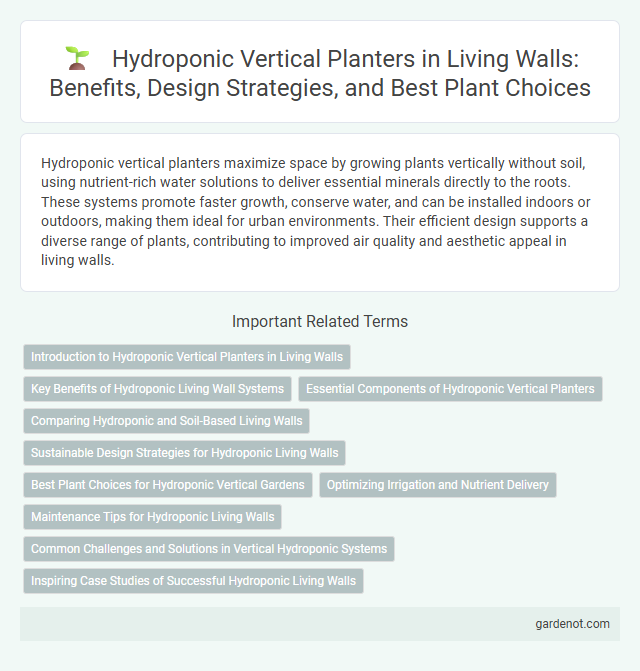Hydroponic vertical planters maximize space by growing plants vertically without soil, using nutrient-rich water solutions to deliver essential minerals directly to the roots. These systems promote faster growth, conserve water, and can be installed indoors or outdoors, making them ideal for urban environments. Their efficient design supports a diverse range of plants, contributing to improved air quality and aesthetic appeal in living walls.
Introduction to Hydroponic Vertical Planters in Living Walls
Hydroponic vertical planters in living walls utilize nutrient-rich water solutions instead of soil to grow plants efficiently in vertical structures. These systems maximize space by allowing multiple plant species to thrive in compact urban environments, promoting sustainability and improved air quality. Advanced hydroponic technologies enable precise control over water, nutrients, and light, fostering faster growth and higher yields in living wall installations.
Key Benefits of Hydroponic Living Wall Systems
Hydroponic vertical planter systems offer significant water efficiency, using up to 90% less water compared to traditional soil gardening, making them ideal for urban environments. These living walls improve air quality by filtering pollutants and increasing oxygen levels, contributing to healthier indoor and outdoor spaces. Their modular design maximizes limited space, enabling year-round cultivation of diverse plants without soil, reducing pest issues and maintenance needs.
Essential Components of Hydroponic Vertical Planters
Hydroponic vertical planters rely on essential components including a sturdy frame, nutrient-rich water circulation system, and a growing medium such as coconut coir or rockwool to support plant roots. Integrated drip or wick irrigation systems ensure consistent delivery of water and nutrients, optimizing plant growth in compact vertical spaces. LED grow lights and automatic sensors enhance growth conditions by monitoring moisture, pH, and nutrient levels in real time.
Comparing Hydroponic and Soil-Based Living Walls
Hydroponic vertical planters use nutrient-rich water solutions to grow plants without soil, resulting in faster growth rates and higher yields compared to traditional soil-based living walls. These systems optimize water usage by recycling nutrient solutions, reducing overall consumption by up to 90% compared to soil-based counterparts. Maintenance requirements are generally lower in hydroponic setups due to fewer issues with pests and soil-borne diseases, making them an efficient and sustainable option for urban green walls.
Sustainable Design Strategies for Hydroponic Living Walls
Hydroponic vertical planters exemplify sustainable design strategies by minimizing soil use and optimizing water efficiency through closed-loop irrigation systems. These living walls enhance urban biodiversity and improve air quality by integrating native plant species that thrive in hydroponic conditions. Utilizing lightweight, modular materials further reduces structural load and enables scalable installation in diverse indoor and outdoor environments.
Best Plant Choices for Hydroponic Vertical Gardens
Choosing the right plants for hydroponic vertical gardens ensures optimal growth and aesthetics. Leafy greens such as lettuce, spinach, and kale thrive due to their fast growth and low nutrient demands, making them ideal for hydroponic systems. Herbs like basil, mint, and thyme also perform well, benefiting from consistent water supply and space efficiency in vertical planters.
Optimizing Irrigation and Nutrient Delivery
Hydroponic vertical planters maximize irrigation efficiency by delivering nutrient-rich water directly to plant roots through a closed-loop system, reducing water waste by up to 90%. Advanced drip emitters and timers enable precise control over moisture levels and nutrient flow, promoting faster plant growth and higher yields. Integration of sensors monitors real-time nutrient concentration and pH, ensuring optimal plant health while conserving resources in living wall installations.
Maintenance Tips for Hydroponic Living Walls
Regularly monitor water pH levels, ideally between 5.5 and 6.5, to ensure optimal nutrient absorption in hydroponic living walls. Clean and inspect the irrigation system weekly to prevent clogging and algae buildup that can hinder plant growth. Replace nutrient solutions biweekly and prune plants to promote healthy development and prevent overcrowding.
Common Challenges and Solutions in Vertical Hydroponic Systems
Hydroponic vertical planters often face challenges such as nutrient imbalance, water distribution issues, and root diseases due to limited space and high plant density. Implementing automated nutrient monitoring systems, ensuring even water flow with drip irrigation, and using sterile growing mediums can effectively mitigate these problems. Regular maintenance and selecting disease-resistant plant varieties further enhance the system's productivity and longevity.
Inspiring Case Studies of Successful Hydroponic Living Walls
Hydroponic vertical planters have transformed urban spaces through innovative designs like the Bosco Verticale in Milan, which integrates thousands of plants to enhance air quality and biodiversity. Case studies from Singapore's Changi Airport demonstrate how hydroponic living walls contribute to passive cooling and aesthetic appeal in high-traffic environments. The successful implementation of hydroponic systems in commercial and residential settings underscores their potential for sustainable urban greening.
Hydroponic vertical planter Infographic

 gardenot.com
gardenot.com